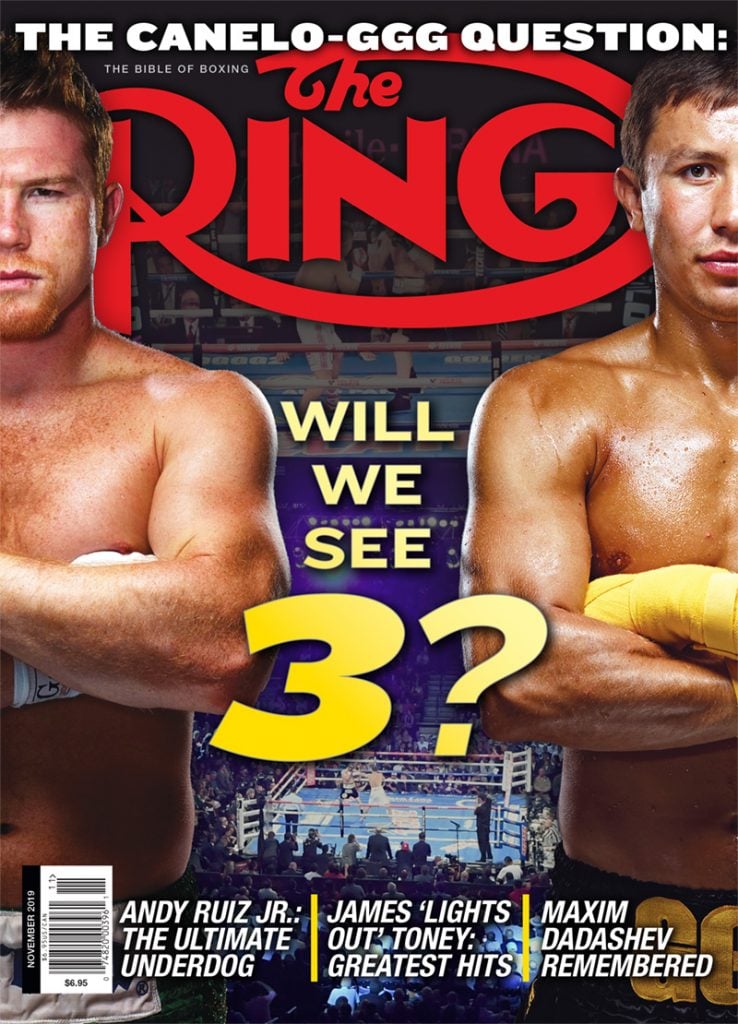The Travelin’ Man goes to Alberto Palmetta vs. Erik Vega: Part Two
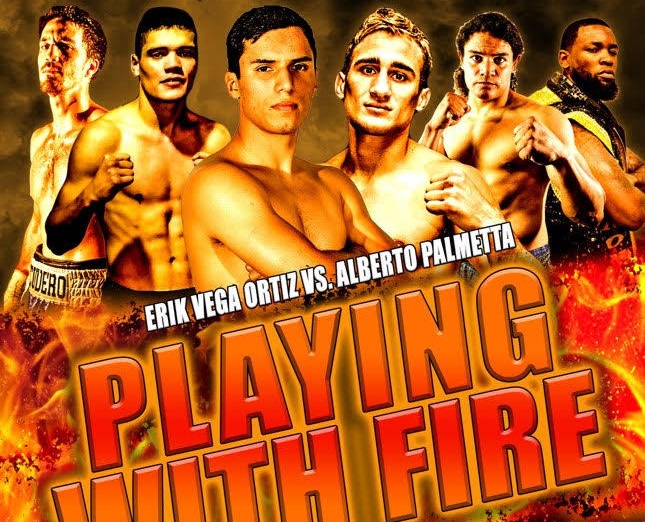
Please click here to read Part One.
Friday, November 15 (continued): Entering the 10th and final round, the main event between once-beaten 2016 Argentine Olympian Alberto Palmetta and undefeated Mexican Erik Vega was a briskly-paced nip-and-tuck affair with multiple shifts of fortune. While the CompuBox numbers slightly favored the taller Vega (154-140 overall but only 123-120 power), the judges saw Palmetta ahead 87-84 (twice) and 86-85.
In virtually every fight that gets to a final round, whether it’s close or not, at least one chief second urges his charge to produce an all-out attack. Few do but the 29-year-old Palmetta was different; he sensed the moment and seized the opportunity in most emphatic fashion once he sensed he had hurt his 24-year-old opponent. Thanks to a furious and impressively accurate assault, referee Mark Nelson intervened and declared Palmetta the victor, raising his record to 13-1 (with 9 knockouts) while eroding Vega’s to 16-1 (with 9 KOs).
“I knew we were up on the scorecards,” Palmetta reportedly said after the fight. “We didn’t need the knockout but we wanted it. I had hurt him a couple of times in the fight but I didn’t follow up. In the 10th, I had him out on his feet. It was a good stoppage. He was done.”
The numbers illustrated the ferocity and the effectiveness of Palmetta’s final assault. In the 63 seconds that the 10th round officially lasted, Palmetta fired 59 punches to Vega’s 20, launched 56 power punches to Vega’s 15, led 51%-15% overall and 50%-7% power and prevailed 30-2 in total connects and 28-1 in landed power punches. That surge vaulted Palmetta to final leads of 170-157 overall and 148-124 power to offset Vega’s 33-22 edge in landed jabs. But while Palmetta was the more accurate hitter (25%-23% overall, 32%-27% power), Vega was more active as he averaged 74.7 punches per round to Palmetta’s 71.4 – both well above the 56.8 welterweight average. The CompuBox round-by-round breakdown of total connects – relevant because clean punching is a key judging factor – had Vega ahead 5-4 entering the final round, mostly because he threw more punches in seven of the nine rounds, including gaps of 114-88 and 100-84 in rounds eight and nine.
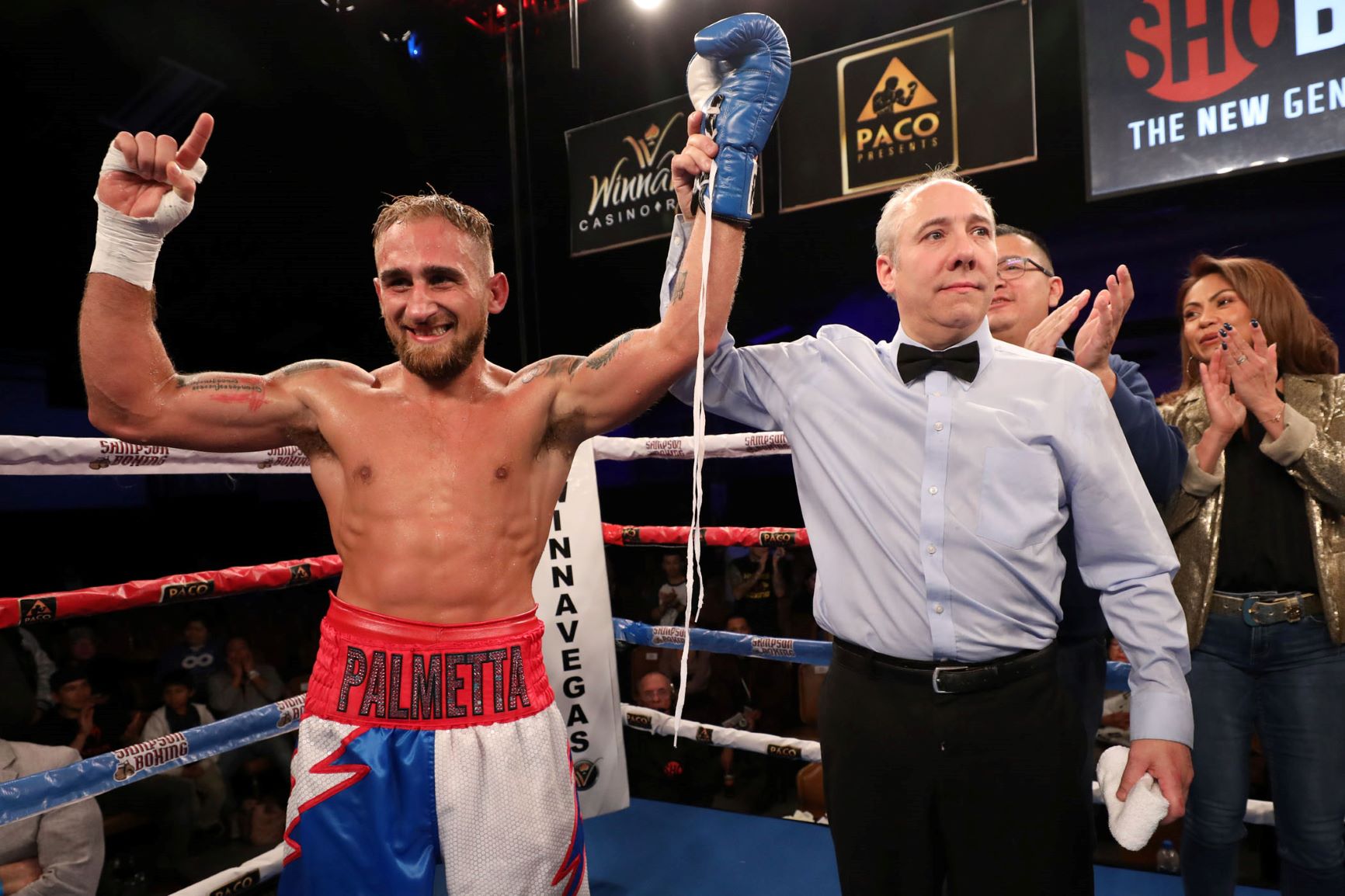
Alberto Palmetta (pictured) stopped Erik Vega in 10 (Photo by Dave Mandel/Showtime)
To his credit, Vega accepted the final result and even agreed with Nelson’s action.
“We don’t make excuses,” he reportedly said. “I believe the referee was right in stopping the fight. I think I need to practice more and I needed to throw more combinations. This was a great learning experience. We’ll go back to the drawing board and come back stronger.”
Vega is said to have modeled his style – and apparently his classy post-fight behavior – after Hall-of-Famer Ricardo Lopez (who, by the way, never lost a fight; his record was 51-0-1 with 38 knockouts). Inside the ring, there were elements of Lopez’s game in the Mexican’s approach – upright stance, high guard, tucked-in elbows, long and straight punches, subtle upper body movement – but he had nowhere near the single-shot power Lopez wielded. Palmetta’s southpaw stance and defensive skill limited Vega’s jab to 14% accuracy and while Vega landed frequently to the body (body shots made up 62 of Vega’s 157 total connects), his shots lacked the heft to seriously empty Palmetta’s gas tank the way Lopez’s body punches once had. Meanwhile most of Palmetta’s damage was done to the head (139 of his 170 total connects were targeted there) and despite not having fought more than six rounds in any of his previous fights, he proved that the power that had crafted a six-fight KO streak coming in was more than sufficient to add a seventh in the 10th round of a demanding fight against one of his best opponents to date. Palmetta also showed once more that his game travels well, for he lifted his record in the U.S. to 5-0, all by KO.
*
Perhaps Palmetta’s final-round surge was a reaction to what happened to countryman Marcos Escudero in the co-feature. Most observers – especially the Showtime broadcast team of Barry Tompkins, Steve Farhood and Raul Marquez – viewed Escudero as an easy winner over Joe George, but while judge Gloria Martinez saw Escudero ahead 96-94, she was overruled by Bob LaFratte and Carlos Sucre, who scored the bout 97-93 and 97-94 respectively for George.
The basis for the outrage was the vast difference in output favoring Escudero – 91.1 punches per round to George’s 54.5 – and his more sustained aggression. That aggression was at its peak in the first three rounds as he threw 135, 112 and 92 punches to George’s 58, 60 and 59, resulting in connect leads of 69-50 overall and 61-42 power. Incidentally the 135 punches Escudero unleashed in round one tied for the seventh most ever recorded by CompuBox in a light heavyweight fight with Nathan Cleverly’s fifth round effort against Karo Murat in September 2010.
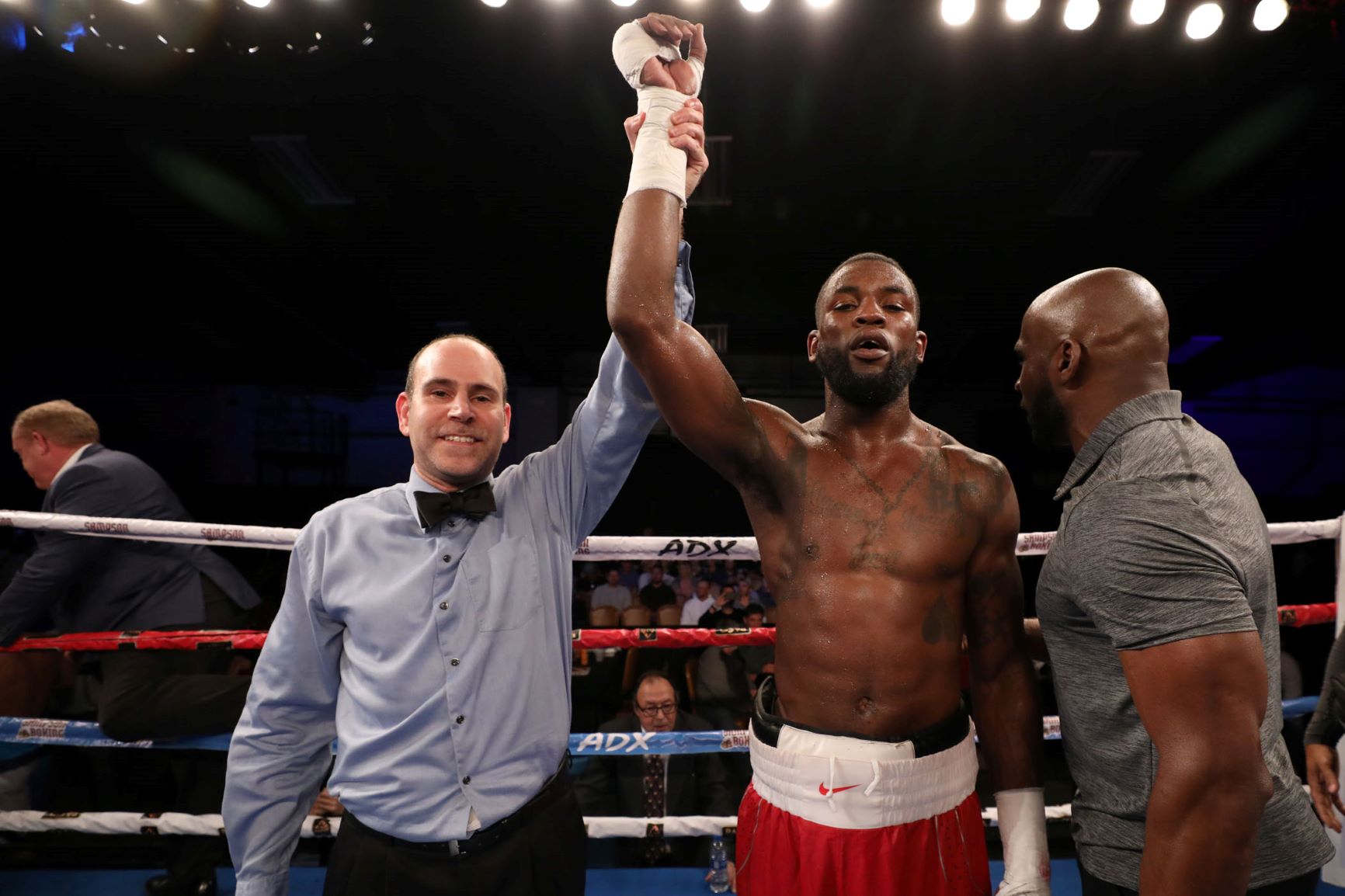
Joe George (center). Photo credit: Dave Mandel/Showtime
While I agree that Escudero performed well enough to win – he led 6-4 in the CompuBox round-by-round breakdown of total connects – and while I disagree with the margins favoring George by LaFratte and Sucre, I can see how George could have been seen as a close winner in this fight (but not by margins of 97-93 or 97-94). First, George’s punches connected more cleanly and with more force than Escudero’s, an important factor in the pro game, and he managed to stun Escudero in round nine. Second, after Escudero’s quick start, George chipped away in rounds four through nine as he out-landed the Argentine in four of those six rounds and in three of the final four rounds leading up to round 10. Finally George not only was the harder hitter, he was the more accurate one as well as he prevailed 30%-19% overall, 25%-9% jabs and 32%-25% power. It was clear that LaFratte and Sucre preferred George’s precision and impact over Escudero’s sheer volume and if they saw enough of an edge through that prism to swing enough close rounds his way, then that could explain their math.
The 10th round was the clincher for me, for Escudero out-threw George by nearly two-to-one in total punches (106 to 58) and in power shots (82 to 48) while also out-landing him 26-20 overall, 4-2 jabs and 22-18 power. That surge enabled Escudero to extend his final leads to 177-161 overall and 146-119 power – not exactly a margin that would characterize a Sloan robbery of the scale of the first Zhora Hamazaryan-Thomas Mattice fight in July 2018. By the way, LaFratte judged that fight and he was the only jurist who had it right by seeing Hamazaryan a 77-74 victor.
To sum up – and with apologies to the late Texas senator and 1988 Vice Presidential nominee Lloyd Bentsen – I was at Hamazaryan-Mattice I. I knew the first Hamazaryan-Mattice fight well. And, in terms of “robberies,” Escudero-George was no Hamazaryan-Mattice I.
*
While chatting with promoter/manager Samson Lewkowicz at ringside a few hours before the telecast, he spoke extremely highly of middleweight Amilcar Vidal, who, like Lewkowicz, is a native of Uruguay. He told me of the considerable time and effort he invested in the prospect and about the miraculous recovery Vidal made after being struck by a car while doing roadwork four years earlier. The accident shattered Vidal’s pelvis, left a long scar down his left arm and required two months of hospitalization as well as a year of rehabilitation. At first, the doctors treating him said he would never walk again, much less box, so his competing inside a ring in Sloan, Iowa, represented a major victory. Lewkowicz said that if any one fighter was going to steal the show, it was going to be Vidal, who sported a glossy 9-0 (with 8 KOs) record.
As usual, Sampson was right.
Following a period of gauging distance and leverage against the 9-0 (with 6 KOs) Zach Prieto, Vidal cashed in big in the late stages of round one. A swooping left hook/uppercut to the point of the chin scored the fight’s only knockdown, then, after Prieto was authorized to continue, Vidal prompted referee Mark Nelson to intervene with a power volley capped by a hook to the side of the head. It didn’t matter much that only one second remained in the round, for Nelson believed enough damage had been inflicted to warrant his move.
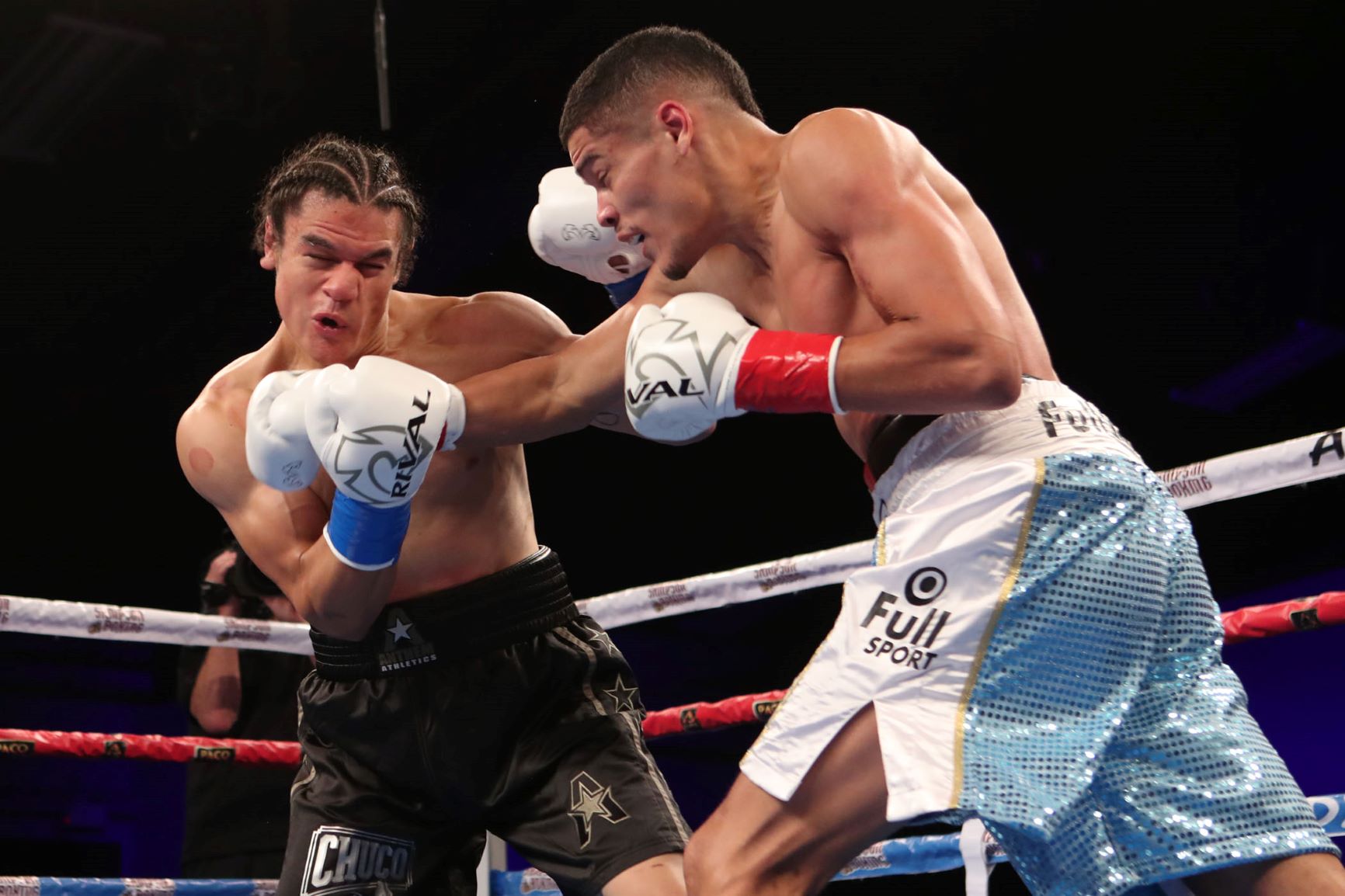
Amilcar Vidal (right) vs. Zach Prieto (Photo by Dave Mandel-Showtime)
Up until the final moments, the fight had been relatively even in terms of statistics. However Vidal dropped the hammer in the last 60 seconds by out-landing Prieto 13-1 overall and 10-1 power to establish final leads of 22-14 overall, 6-5 jabs and 16-9 power as well as 39%-26% overall, 38%-29% jabs and 39%-24% power. The output was nearly even – Vidal led 57-55 in total punches thrown and 41-38 in attempted power punches – but Vidal did much more with his than Prieto and the result was the second consecutive “ShoBox” opener that ended in round one.
A recent trend with ShoBox telecasts has been to reward outstanding performers in co-featured bouts by inserting them into the main event the next time out. After Ruben Villa produced a sparkling eight-round decision victory over Ruben Cervera on the January 2019 ShoBox episode topped by Devin Haney’s 10-round victory over Xolisani Ndongeni, he was elevated to the top spot in his next appearance four months later and responded with another excellent victory over Luis Alberto Lopez. In April 2019, Xavier Martinez shined in blowing out John Moralde in three rounds on the Angelo Leo-Neil John Tabanao broadcast and followed with a 21-second crushing of Jessie Cris Rosales just two weeks ago. However lightweight Michael Dutchover, who crushed Rosekie Cristobal in just 106 seconds on the Villa-Lopez undercard, headed a show in his hometown of Midland, Texas, and was stopped in eight by Thomas Mattice. Will Vidal be granted a similar opportunity a few months down the road? And will he follow the path set by Villa and Martinez or will he suffer the fate of Dutchover? We might see these answers sometime in 2020.
*
After grabbing a sub sandwich and a small bag of Cheetos from the production office, Andy Kasprzak, stage manager Mike Shea and I hustled out to Andy’s rental car and returned to the crew hotel. As is always the case, my night’s work wasn’t quite over as I needed to input the night’s numbers into the master database, then send the files to the Draft Kings people as part of their year-long picks contest. Because I took my time consuming my bounty – and because it usually takes me a while to wind down from working a show – I didn’t turn out the lights until 2:45 a.m.
Saturday, November 16: I awakened after five somewhat uneasy hours of rest and slumber but the morning routines helped restore my energy level enough to crank out plenty of words on the laptop. For me, there is something about the writing process that condenses my sense of time and just before I reached what I felt was a good stopping point, I realized that I was mere minutes away from the agreed-upon 10:30 a.m. meeting time for our carpool to the airport. Andy, Mike and I were to be on the same 12:37 p.m. flight to Chicago’s O’Hare International Airport and, as expected, all of us arrived in the lobby on time. But while we three were appropriately punctual, it became evident that Sioux City’s airport wasn’t quite ready to receive us – or anyone else. The proof: Even at this relatively late hour of the morning, the security screening area was unstaffed and gated shut.
Stimulating conversation has a way of melting the time away, and most of it was spent with Andy and Mike as well as with technical wizard Paul Tarter (the man who makes sure our CompuBox laptops are electronically melded with the production truck, among other duties). However once the security area opened and we were summoned to form a line, I learned that many of the usual TSA Pre-Check privileges I need were not in play.
For the uninitiated, passengers with TSA Pre-Check have the benefit of expedited screening procedures; we can leave our shoes and light jackets on, our laptops inside our bags, our liquids inside our luggage and we walk underneath simple metal detectors instead of submitting to the full-body scanning machines. But here, I had to unpack everything and, as a result, I had to use five trays to accommodate this protocol (one tray each for my two laptops, one for my liquids, one for my windbreaker jacket and one tray for my shoes. The total would have been seven but the TSA allowed me to place my laptop bag and my clothes bag directly on the conveyor belt and I was allowed to keep my cell phone, change and other metallic items inside my laptop bag. Needless to say, it took me quite a while to disassemble and reassemble my belongings and I was intensely aware of how my lengthy process was affecting those behind me in line. Thankfully none of them said a word.
Although my situation was bad enough, Paul’s was even worse, thanks to the numerous devices inside his various bags. Between me and Paul, we were endangering the availability of trays for the other passengers but we somehow passed through without further upsetting the apple cart.
Although my ears continued to pop during the Sioux City-to-Chicago leg, I experienced none of the pressure inside my head that I felt two days earlier. While Andy had to dash away to his connecting flight to Boston, Mike and I had several hours to kill before our respective flights to LaGuardia and Pittsburgh, so we decided to indulge in a leisurely lunch.
Every so often, I have witnessed and experienced episodes in life that can only be explained by something beyond. Longtime readers of this column know that these circumstances happen often with me on these trips and I choose to believe that a newly-coined word, “Godwink,” adequately captures my sentiment. According to one online dictionary, a Godwink is “an event or personal experience, often identified as coincidence, so astonishing that it is seen as a sign of divine intervention, especially when perceived as the answer to a prayer.”
Unlike the others, however, this episode wasn’t mine – it was Mike’s. In retrospect, the first seed was planted a few hours earlier at the Sioux City airport’s waiting area when Mike, Andy and I were discussing Super Bowl champions of the past. Mike said that when he was growing up, the horrific performance of his home team (the New York Giants) in the 1970s prompted the need for he and his brothers to choose other teams to support. Mike chose the Pittsburgh Steelers while one of his siblings chose the Oakland Raiders and a third, a half-brother, was a strong supporter of the Minnesota Vikings – all of whom played in the Super Bowl during the decade. For some reason my mind retained this conversational nugget.
After deplaning in Chicago, I looked at a nearby electronic board to assess possible places to have lunch. Since our gates were in Terminal H, the one that caught my eye was the Chicago Cubs Bar and Grill located at the Rotunda and I suggested we go there if nothing else caught our eyes. Nothing did, so when we arrived, Mike asked, “Why don’t we eat here?”
We found a table but, after a few minutes, we decided to move to another one so we would be seen more easily by the servers. While I took a seat with my back to the rest of the restaurant, Mike was facing in the opposite direction.
A few minutes after repositioning ourselves, Mike looked down at his phone and read a text that caused his face to crinkle in confusion.
“What’s going on?” I asked.
“I think I just got a text from my brother,” he replied.
“What does it say?” I said.
“It says, ‘Are you at O’Hare?’ How does he know I’m at O’Hare?”
We soon found out why: His half-sibling, John Paoletti – the brother who had chosen to follow the Minnesota Vikings as a youth – was seated just three tables directly in front of ours. They had not seen one another in more than four years and neither had any idea the other was traveling through Chicago on this day. Needless to say, it was a most happy and unexpected reunion.
For this to happen, many circumstantial gears had to lock into place. Consider:
* JT Townsend is the stage manager for most of the ShoBox cards but Mike was summoned to work the Sloan show because JT was committed to work a New Jersey Devils telecast.
* O’Hare has 137 places where one can eat, including 21 in Terminal H and 10 in the Rotunda. We could have chosen any of the other 20 in the terminal and any of the other nine in the Rotunda but, because I was in the mood to have hot dogs once I scanned the electronic board, I suggested to Mike that we go to this one restaurant that was in close proximity to both of our gates. Mike could have rejected my suggestion and, because I tend to be accommodating, I probably would have gone along with whatever other option he chose. But here, he happened to stay with mine.
* The area inside the restaurant is rather large and there were plenty of empty tables from which to choose. After picking our first table, we changed our minds and moved to another about five feet over – a table that was better positioned in relation to where John was sitting.
* It was fortuitous that Mike was looking toward the front of the restaurant bar when we changed tables instead of me, for had the positions had been reversed, John would not have been able to see – or recognize – Mike’s face.
* The time window was very tight; John flew into O’Hare from Greensboro, North Carolina, at 1:10 p.m. and was preparing to catch a flight to his adopted home in Anchorage, Alaska, that was supposed to depart at 2:55. John had just finished his own meal when he spotted Mike and they had enough time not just to re-connect but to catch up.
What a wonderful story. And I thank the both of them for giving me permission not only to tell it but also to snap this picture:
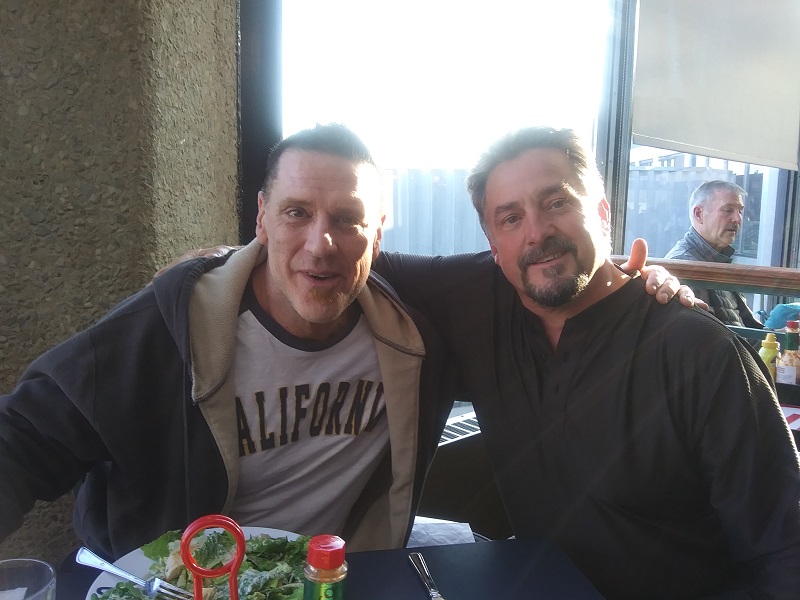
Mike Shea (left) and John Paoletti. Photo credit: Lee Groves
Mike and John texted their seven other siblings in their blended family and every one of them expressed surprise and astonishment.
When God winks, He does so in a most powerful way.
I was looking forward to the Chicago-to-Pittsburgh leg because one day earlier, I learned that I had been upgraded to First-Class. The only drawback was that I was seated in row one, which meant that I had to store both bags in the overhead bin. No matter, I dug out my book and prepared to settle in for the hour-long journey toward “The Steel City.”
However I didn’t have a chance to read more than a page thanks to my seatmate, a vice president of sales at IBM with a passion for college football (especially Notre Dame football since he’s an alum) and for the English Premier League (especially Liverpool). Our mutual love of sports in general instantly broke the ice and created a nice bond over the course of the next hour.
Saturday evening traffic was light, so I returned home just two hours and 15 minutes after I began. As I write this, I have only one more trip scheduled for 2019 – a “Showtime Championship Boxing” card that will feature Gervonta Davis versus Yuriorkis Gamboa at lightweight and Jean Pascal versus Badou Jack for Pascal’s “interim” WBA light heavyweight title. Happily the host city – Atlanta – will be far away from the snow belt.
Until then, happy trails!
*
Lee Groves is a boxing writer and historian based in Friendly, West Virginia. He is a full member of the BWAA, from which he has won 16 writing awards, including two first-place awards, since 2011. He has been an elector for the International Boxing Hall of Fame since 2001 and is also a writer, researcher and punch-counter for CompuBox, Inc. He is the author of “Tales from the Vault: A Celebration of 100 Boxing Closet Classics” (available on Amazon) and the co-author of “Muhammad Ali: By the Numbers” (also available on Amazon). To contact Groves about a personalized autographed copy, use the email [email protected] or send him a message via Facebook.
Struggling to locate a copy of The Ring Magazine? Try here or
Subscribe
You can order the current issue, which is on newsstands, or back issues from our subscribe page.



